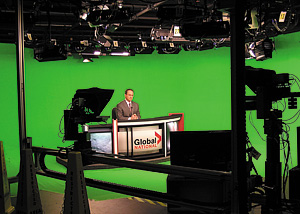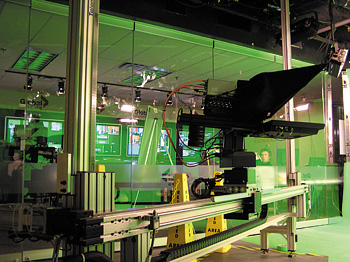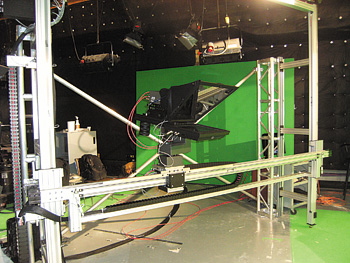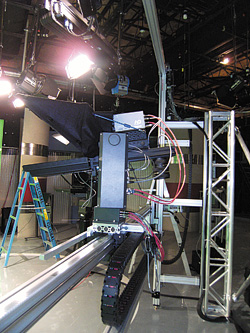A Big Market Look for Small Markets
VANCOUVER, British Columbia To improve the on-air look for its local stations—and advance them towards a digital workflow and ultimately HDTV—Canadian network Global TV has adopted a centralized production control model. While remote production control is nothing new, what is newsworthy about Global TV is the scope of its operation and their remote control, keying and rendering of 3D virtual sets.
Because of this remote production control strategy, all of Global TV’s owned and operated stations—even those in small prairie towns—are now on the same footing, with the same capability to present a polished, high-end on-air look that attracts and retains viewers.
COST-EFFECTIVE STRATEGY

On the set of Global National, News Anchor Kevin Newman is framed by Telemetrics' H-frame positioning system.
Today, production control for live newscasts emanating from seven local Canadian stations from coast to coast is managed remotely from three central production centers—in Vancouver, Edmonton, and Calgary; with plans to bring a fourth production control center in Toronto online in early 2009 to serve an additional three stations. Each local station has a green screen virtual studio with tracked robotic cameras and a broadband network to send multiple video streams, camera data, and IFB back to the production control centers in realtime.
These centers are equipped with HD-ready production control rooms staffed by experienced technical teams that have full remote control over the cameras, lights, audio, graphics, roll-ins, feeds, and play-out at the local stations. They use Telemetrics camera tracking data and Orad ProSet and HDVG virtual set technology to transform the green screen studios by remotely inserting advanced 3D virtual sets that move realistically in relation to studio camera positions.

Telemetrics H-frame elevating belt track system, complete with Telemetrics Pan/Tilt unit on the set in Vancouver.
“While it’s easy to justify spending $3-$4 million on an HD-ready production control room at a large market station where ad revenues and operational savings can lead to a rapid return on investment,” said Gerry Belec, director of technology and design for Global TV, the second largest broadcaster in Canada, and a wholly owned subsidiary of CanWest Global Communications in Vancouver, “it’s very difficult to justify this huge capital investment at a small market station that doesn’t have the market share or revenue base to make its money back. “That’s the problem we’re solving with this central production model. We can amortize our capital investment in equipment and 3D virtual sets across all of our stations. And we can maximize the talents of the highly skilled production teams that staff our central production control rooms by having them handle local newscasts across the country. This strategy makes far more experienced directors and producers available to smaller markets that could never afford that caliber of expertise, while raising production values through the use of sophisticated virtual sets.”
CUTTING CAPITAL COSTS

Telemetrics Pat/Tilt unit with programmable timed presets and H-frame elevating belt track system deliver smooth, operator-like camera movements. Belec said that without this strategy, it would be impossible for them to justify bringing major market production standards, and eventually HDTV, to their local stations. The savings stem from building and staffing only four HD-ready production control rooms rather than seven, in each of the local markets, which include Ottawa, Montreal, Red Deer, Winnipeg, Victoria, Halifax, and Lethbridge. Three additional local stations, which will be served from the Toronto production center come online in early 2009, (including Saskatoon, Regina, and Hamilton), bringing the total station count to 10.
The system is designed to allow any of the four central production control rooms to remotely control any Global TV studio on the virtual private network, with connectivity ranging from DS3 to OC3. Since Global TV’s stations are located across Canada, the four production control rooms can juggle live productions of multiple newscasts across five and a half different time zones. For example, the Vancouver production control center can control Montreal’s 6:00 p.m. newscast at 3:00 p.m., thousands of miles away, and still have time in the afternoon to produce evening newscasts for other stations in the central or western regions of the country.
LOCAL PRESENCE

Telemetrics robotic devices and serial control panels communicate with each other through Ethernet networks. Global TV produces a national newscast in Ottawa that is carried by its network of stations. But in keeping with Global TV’s mission to provide locally produced newscasts, Belec said that each Global TV station has its own reporters, editors, and anchors who determine what news content and perspective is right for their local newscasts. They use the AP ENPS newsroom computer system, which is seamlessly integrated with the Orad ProSet system through the use of an ENPS/MOS plug-in. Before each live newscast, the on-camera talent goes into the studio, sits at a desk, clips on the mic, and with the cue from the central control room, delivers the news in the green screen chromakey environment, while the remote production center controls the studio’s multiple cameras, mic levels, and lights.
But the key to Global TV’s centralized production strategy is that the camera data from Telemetrics camera robotics systems at the local stations is integrated and synchronized with an Orad ProSet 3D SD/HD virtual set system and Ultimatte 11 HD keyer at the central production sites.
“The Telemetrics solution provides a real-time high-resolution camera telemetry that provides Orad with the ability to move the camera set in real-time,” said Anthony Cuomo, vice president and general manager for Telemetrics Inc., in Mahwah, N.J. “To accomplish this seamless integration, we had to work very closely with Orad to enable the camera tracking data being sent from the local studios to mesh frame-accurately with the virtual background rendered by Orad’s HDVG [High-Definition Video Graphics] at the production centers.
“One of the key benefits of the H-track is its ability to simulate a boom in a small studio,” Cuomo added. “The combination of the H-track and virtual studio provides the look of a larger studio.”
VIRTUAL REMOTE SETS
By using the Telemetrics H-frame elevating belt camera track positioning system with X and Y axis—including the floor to ceiling version model BT-TRK-010 and the wall-mounted model BT-TRK-008—the camera could start with a high shot of the anchor desk and then move down, making it seem as if there was a camera boom operator in the studio, according to Cuomo.
“Orad’s part is the remote chromakeying, image processing, and rendering of the virtual set using multiple video streams and camera tracking data from the stations,” said Shaun Dail, Orad’s New Jersey-based vice president of sales and marketing for North America. “Our ProSet software also interfaces with the stations’ ENPS systems so they can bring in their news data, graphics, and other studio elements.” Also in use is Orad’s Maestro HD/SD 3D character generator for live graphics, which also interfaces with ProSet.
“Since the pictures arrive before the camera data, and since these delays vary between locations, we use an Evertz GPS frame sync to make sure the different delays are always synchronized at the control centers prior to rendering the virtual sets,” said Dail. “Through our close collaboration with Ultimatte, our ProSet software allows on-camera talent to appear to move in and out of virtual objects. We also enable virtual plasma monitors within the 3D virtual set into which live video and graphics can be mapped—the way newscasts use real monitors and monitor walls on a physical set.”
RAPID ROI
Dail estimated that Global TV’s return on investment could be measured in months rather than years. “When viewers in small markets see a big market look, they like it more, and that makes it easier to sell ads and promotes a healthier bottom line,” he said.
Global TV’s 3D virtual sets were designed by Full Mental Jacket of Los Angeles using off-the-shelf tools, such as 3D Studio Max, Adobe After Effects, and Adobe Photoshop—or any design software with VRML export capabilities—as well as Orad’s own 3Designer authoring software, and then ingested to the ProSet HDVG rendering platform.
“What we’re doing here at Global TV isn’t a technical challenge. It’s a cultural challenge. Any station can buy the same equipment we bought and configure it the same way,” said Belec. “The real challenge was getting our production people to dramatically change their workflow to accommodate this innovative use of technology.”
Get the TV Tech Newsletter
The professional video industry's #1 source for news, trends and product and tech information. Sign up below.

